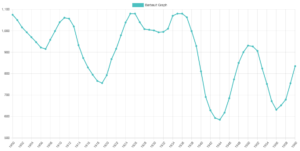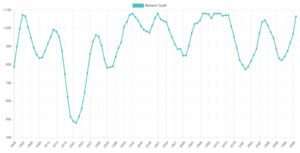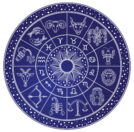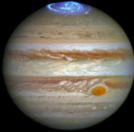The Astrology of Time and The Plato Perspective

In the Socratic dialogue Timaeus, which is really more of an inarguable monologue, Plato explains the origins of the universe. The dialogue is remarkably sympathetic to astrology. Plato considered the planets to be the first born thoughts of God.
In Timaeus, he believes when the Demiurge or Being responsible for creation was framing the universe He put intelligence in soul and soul in body so the world could become a living being endowed with soul and intelligence by His providence.
Not just our world but all the planets in the solar system, about which Timaeus advises, “God invented and gave us sight to the end that we might behold the courses of intelligence in the heaven and apply them to the course of our own intelligence which are akin to them.” A beautiful definition and endorsement of astrology. (1)
This was not biblical “ex nilhilo,” willed out-of-nothing kind of creation though. The Demiurge fashioned the cosmos from the four elements which were already available to Him, although the planets supposedly have their own element or “quintessence” too, which is not in us. Then Man was created out of what remained of the elements mingled with soul but not of the same elemental purity as our planetary avatars.
Plato even attempts to explain the subatomic. The elements themselves are said to be composed of types of triangles, which is inexplicable but it does demonstrate a philosophy informed by Pythagoras and geometric principles, and his reverence for the Egyptian pyramids and 9,000 years before Timaeus, the civilization of Atlantis, which is the other major topic of Timaeus.
The creation of the planets seems to have occurred outside of or before time began based on Plato’s metaphysics which includes both a world of immutable Being and perfect Forms and the world of imitation that human beings inhabit.
Our created universe was fashioned in the likeness of its immutable Form but apparently not much else came with it, so that required a Demiurge to engineer the rest of creation after the nature of its Forms.
In Plato’s cosmology, the movement of the planets with the intelligences and ensouled qualities they possess collectively serve a singular purpose, which is to make manifest the passage of time. “Now, when all the stars which were necessary to the creation of time had attained a motion suitable to them, and had become living creatures having bodies fastened by vital chains.”
The Demiurge brought order to the movements in the celestial sphere that was not there until He willed it, which means He teed up the orbits of the planets. He then resolved to create a moving image of eternity, and “…when he set in order the heaven, he made this image eternal but moving according to number, while eternity itself rests in unity; and this image we call time.”
So the beginning of time is the start point of the orbits or order of the planets so willed by the Demiurge.
Plato speculated about the end of the world too. He believed there has been and will be again many destructions of Mankind arising out of many causes; the greatest have been brought about by fire and water; lesser ones by innumerable other causes.
Plato the astrologer explains, “Now this has the form of a myth, but really signifies a declination of the bodies moving in the heavens around the earth, and a great conflagration of things upon the earth, which recurs after long intervals; after the usual interval, the stream from heaven, like a pestilence, comes pouring down, and leaves only those of you who are destitute of letters and education; and so you have to begin all over again like children, and know nothing of what happened in ancient times, either among us or among yourselves. In the first place you remember a single deluge only, but there were many previous ones.”
So the Anthropocene repeats itself and survivors have to start again in ignorance. (2) The fulfilment of a “perfect year” or time’s up for civilization occurs when all revolutions of the planets, “having their relative degrees of swiftness, are accomplished together and attain their completion at the same time.” Plato is describing a grand conjunction of planets.
A perfect year or one cycle of human civilization is not Plato’s idea alone. The mathematically advanced Assyrians 500 years before Plato believed the Apocalypse repeated cyclically too, when all seven visible planets were either conjunct in Cancer or Capricorn, which shows the importance they assigned to the solstices. Plato’s planetary augur for the end of the world was probably borrowed from them.
Plato was not aware of the synodic cycles with the planets past Saturn which is a lot of the movement in the solar system, but it follows if you follow Plato, that when the planets are moving towards each other, aggregately, the world suffers for it and when the planets are moving away from each other, aggregately, life gets better.
Just prior to a grand conjunction all planetary cycles would have to be waning, the half of any cycle when the Ideas associated with it tend to be fully implemented in society but slowly become exhausted or depleted until the Ideas are reborn or renewed at the conjunction phase of their next synodic cycle; a new infusion of planetary Ideas built on the lessons of its previous cycle which ran its course.
The primary mechanism of a solar system clock is the synodic periods of the outer planets. There are ten of them from Jupiter-Saturn to Neptune-Pluto. Their orbits give eternal Time its moving image. Interlocking cycles of planetary pairs which range from the 492 year Neptune-Pluto cycle to the 12 year Jupiter-Pluto cycle, and their intersections which permit the transmission and priming of the Ideas associated with them, combined with the intersections of the shorter cycles of the remaining planets and the daily cycle of the transiting angles until, at an appointed place and time, a fashioning of events around an Idea becomes localized and made manifest. Effective Ideas become trends in the world.
And these transmission points between the synodic periods of the five outer planets have always been there embedded in the regular motions of the planets in their orbits since eternity began because the Demiurge willed it that way. The timings of transiting planets is the physical embodiment of Fate.
Good times are coming, I hear it everywhere I go. Good times are coming, but they’re sure coming slow. Vampire Blues Neil Young
A technique to measure the concentration of outer planets in the solar system over long periods of time was invented and developed by French astrologers Henri Gouchon and Andre Barbault more than 70 years ago as a way to identify periods of international instability. Their technique is called the Cyclic Index which has proven itself to be an accurate metric for taking the world’s temperature over long periods of time, and it affirms Plato.
Here is an example of a Barbault graph of the Cyclic Index for a particularly tumultuous period in recent history. The Y axis is the number of aggregate degrees of separation between the 10 planetary pairs. The X axis is the first 50 years of the 20th century. The deeper the trough in the graph the more concentrated are the outer planets.

I call these troughs in the Cyclic Index Plato’s deep wells of despair and iniquity. Note how the deepest troughs in the graph coincide with the two World Wars and the beginning of the Cold War/Atomic Age which still define our geopolitics. Two atom bombs exploded at the bottom of last century’s deepest well.
The Cyclic Index is simple to construct. Measure and add up the angular distances between the ten outer planetary pairs on the same date, like January 1st, over decades or longer, and then display the results as a graph or a table.
Here is a graph for the 21st century. The results are evocative and also true to Plato’s vision for such a wide-angled and non-granular observation of celestial motions.

Now we know what’s at the bottom of Plato’s deepest well of despair in the 21st century which we are now just starting to climb out of. A global pandemic (pestilence) and definitive climate change that has a lot of Assyrian fire to it for starters. The irony of the pandemic is that when the outer planets were closest together, we had to keep our distance from each other.
But the world looks poised to recover. We can honestly say with this graph that for a long time the quality of life has been deteriorating for most people everywhere and we are still near the bottom of our deepest well. Perhaps what is different now since the Cyclic Index has bottomed out is global recognition that time is against us to solve problems we can no longer afford to ignore to the next generation. When synodic cycles begin to wax again, societies do not tend to go back to old solutions that the Ideas associated with them might have been previously to tackle new emerging paradigms. An evolution of Ideas is always the way forward in a waxing cycle as new versions begin to take shape and weave into the fabric of the future being legislated.
Plato would probably say that the next five years will be qualitatively better than the previous 15 have been, back to the Great Recession of 2008 and maybe even further back than that to 2001 and the American response to jihadism on its own soil which globalized very quickly, the only time so far that Article 5 of the NATO charter has ever been invoked. (“Collective defense means that an attack against one Ally is considered as an attack against all Allies”) (3)
If Plato is correct then I predict Donald Trump on the presidential ballot in 2024 will not win. He just does not represent the forces of unity, progress and the collective good will it takes to move Ideas forward or deal with their labor pains characteristic of waxing cycles. He wasn’t that candidate in 2020 either.
The graph suggests with the worst behind us, a new normal should return over the next decade and then it looks like relative calm for the rest of the century.
Plato gives hope for the future. Obviously it won’t be easy or painless to fix a world on fire but it looks like we will. This is our time as Time’s creators have mandated it. To see that we just needed to pan out in our perspective as widely as Plato to see with eyes to prophesize a better tomorrow.
Illustration: Plato is depicted in Raphael’s The School of Athens fresco in the Vatican, carrying a bound copy of Timaeus.
Footnotes: (1) Timaeus quotes from The Internet Classics Archive (2) Wikipedia (3) NATO
Martin Lipson is Canadian astrologer/consultant living near Kingston, Ontario. Martin also worked for many years in astrology education as a distance tutor and examiner for the Faculty of Astrological Studies in the UK. Mundane astrology is his current field of s




